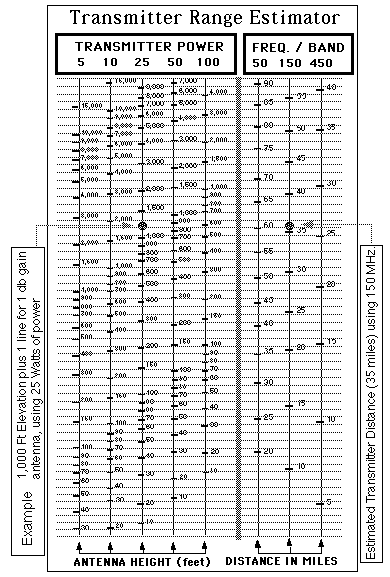 Guide to: Transmitter Range |
Publishing |
| -- Table of Contents -- | -- Return to welcome page -- |
 Guide to: Transmitter Range |
Publishing |
| -- Table of Contents -- | -- Return to welcome page -- |
-- Frequency / Band
-- Transmitter power (in watts)
-- Antenna height (from sea level)
-- Antenna gain (net after coax loss)
Using this estimator table you should be able to calculate the range of your signal. This table can be used not only for mobile or base operation, repeater owners can also estimate the range of their mountain top repeaters! Follow the six steps listed above and you should have a fair estimate of your signal range.
 THE RANGE YOUR SIGNAL WILL TRAVEL CAN BE CALCULATED USING THE ATTACHED CHART. (@ 1 micro-volt RX)
THE RANGE YOUR SIGNAL WILL TRAVEL CAN BE CALCULATED USING THE ATTACHED CHART. (@ 1 micro-volt RX)
1. Locate the height of your antenna on the proper transmitter power column.
2. Find the line closest to that point.
3. Move up one line for every dB gain of your antenna system.
4. Move across the line to the proper vertical frequency band.
5. The closest number to the line is the distance in miles your signal will travel with a 1 micro-volt receive signal.
6. Move up six lines to calculate the .5 micro volt range.
These instructions assume a receive signal in the 1 microvolt range. One microvolt is considered a strong signal strength. Most modern radios have a .15 microvolt sensitivity
If you wish to estimate the maximum distance your signal can be heard, you can move up the distance table six lines every time you divide the receive signal by one half. For a .5 micro volt signal, move up six lines. For a .25 microvolt signal, move up 12 lines.
While these figures are just an estimate, you'll find that they are usually reliable.
73 and remember to have fun.
Look for "Simpletons Ham Dictionary" in 1996.
| Top of this page | Return to welcome page |